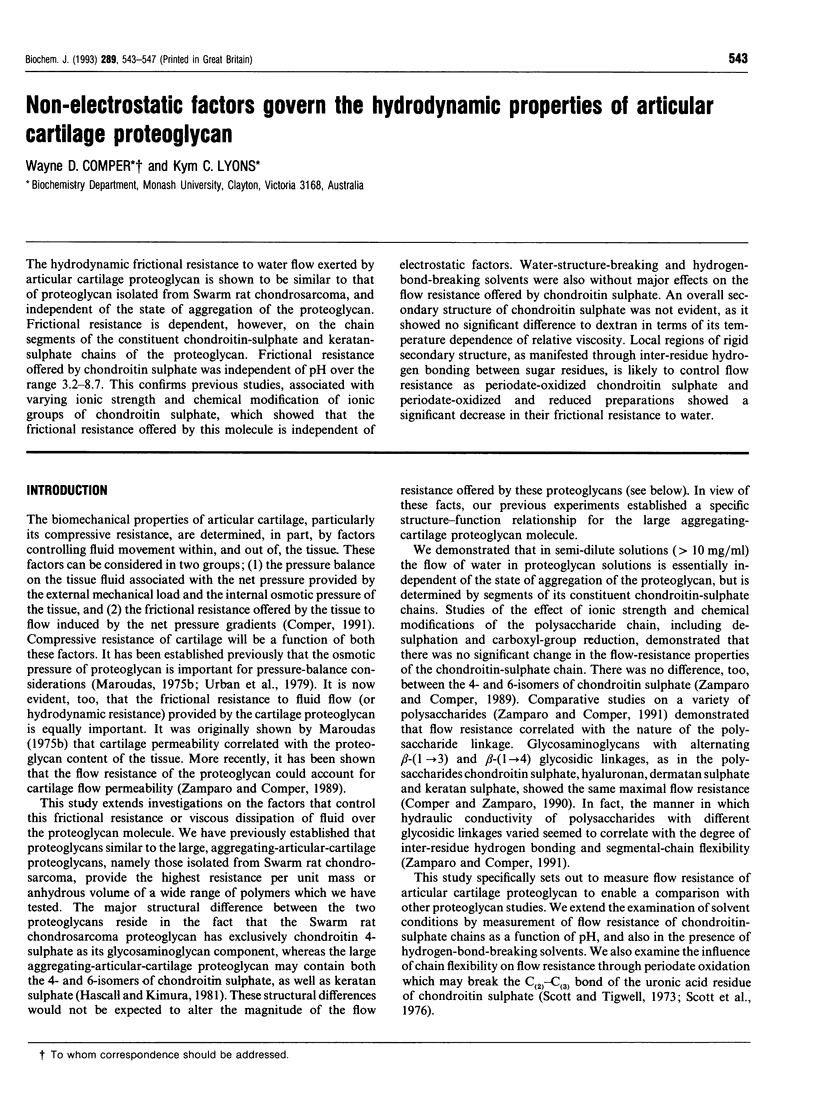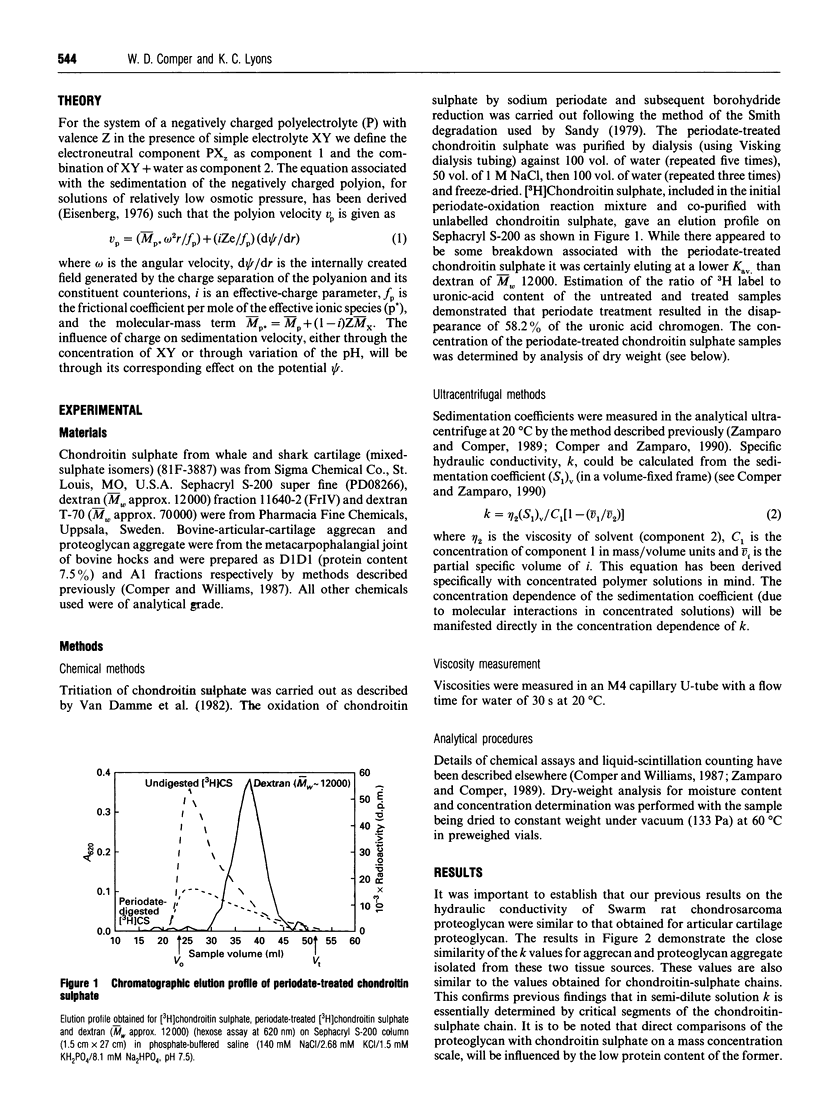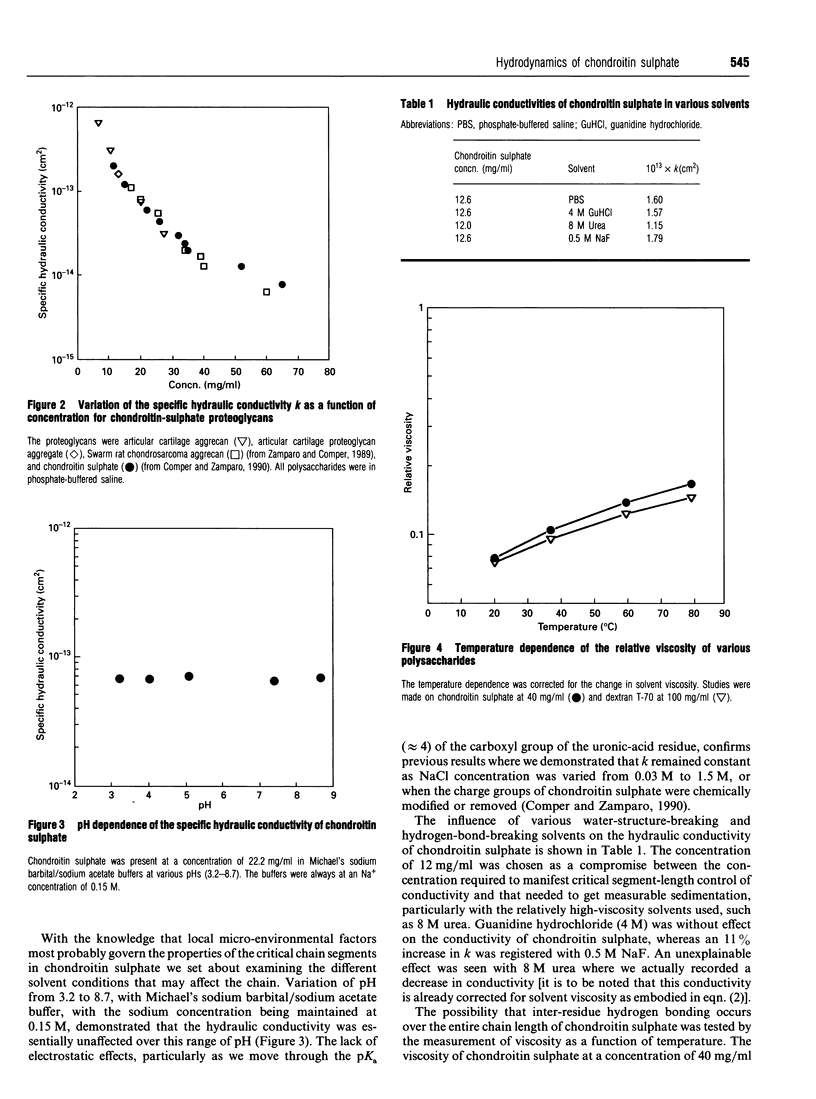Abstract
The hydrodynamic frictional resistance to water flow exerted by articular cartilage proteoglycan is shown to be similar to that of proteoglycan isolated from Swarm rat chondrosarcoma, and independent of the state of aggregation of the proteoglycan. Frictional resistance is dependent, however, on the chain segments of the constituent chondroitin-sulphate and keratan-sulphate chains of the proteoglycan. Frictional resistance offered by chondroitin sulphate was independent of pH over the range 3.2-8.7. This confirms previous studies, associated with varying ionic strength and chemical modification of ionic groups of chondroitin sulphate, which showed that the frictional resistance offered by this molecule is independent of electrostatic factors. Water-structure-breaking and hydrogen-bond-breaking solvents were also without major effects on the flow resistance offered by chondroitin sulphate. An overall secondary structure of chondroitin sulphate was not evident, as it showed no significant difference to dextran in terms of its temperature dependence of relative viscosity. Local regions of rigid secondary structure, as manifested through inter-residue hydrogen bonding between sugar residues, is likely to control flow resistance as periodate-oxidized chondroitin sulphate and periodate-oxidized and reduced preparations showed a significant decrease in their frictional resistance to water.
Full text
PDF




Selected References
These references are in PubMed. This may not be the complete list of references from this article.
- Casu B., Petitou M., Provasoli M., Sinaÿ P. Conformational flexibility: a new concept for explaining binding and biological properties of iduronic acid-containing glycosaminoglycans. Trends Biochem Sci. 1988 Jun;13(6):221–225. doi: 10.1016/0968-0004(88)90088-6. [DOI] [PubMed] [Google Scholar]
- Comper W. D., Williams R. P. Hydrodynamics of concentrated proteoglycan solutions. J Biol Chem. 1987 Oct 5;262(28):13464–13471. [PubMed] [Google Scholar]
- Comper W. D., Zamparo O. Hydrodynamic properties of connective-tissue polysaccharides. Biochem J. 1990 Aug 1;269(3):561–564. doi: 10.1042/bj2690561. [DOI] [PMC free article] [PubMed] [Google Scholar]
- Eisenberg H. Sedimentation in the ultracentrifuge and diffusion of macromolecules carrying electrical charges. Biophys Chem. 1976 Jul;5(1-2):243–251. doi: 10.1016/0301-4622(76)80037-3. [DOI] [PubMed] [Google Scholar]
- Hascall V. C., Jr, Kimura J. H. Biosynthesis, secretion, and aggregation of proteoglycans by rat chondrosarcoma chondrocytes. Ala J Med Sci. 1981 Jan;18(1):29–35. [PubMed] [Google Scholar]
- Heatley F., Scott J. E. A water molecule participates in the secondary structure of hyaluronan. Biochem J. 1988 Sep 1;254(2):489–493. doi: 10.1042/bj2540489. [DOI] [PMC free article] [PubMed] [Google Scholar]
- Maroudas A. Biophysical chemistry of cartilaginous tissues with special reference to solute and fluid transport. Biorheology. 1975 Jun;12(3-4):233–248. doi: 10.3233/bir-1975-123-416. [DOI] [PubMed] [Google Scholar]
- Sandy J. D. The assay of xylosyltransferase in cartilage extracts. A modified procedure for preparation of Smith-degraded proteoglycan. Biochem J. 1979 Feb 1;177(2):569–574. doi: 10.1042/bj1770569. [DOI] [PMC free article] [PubMed] [Google Scholar]
- Scott J. E. Chondroitin sulphate and keratan sulphate are almost isosteric. Biochem J. 1991 Apr 1;275(Pt 1):267–268. doi: 10.1042/bj2750267. [DOI] [PMC free article] [PubMed] [Google Scholar]
- Scott J. E., Heatley F. Detection of secondary structure in glycosaminoglycans via the H n.m.r. signal of the acetamido NH group. Biochem J. 1982 Oct 1;207(1):139–144. doi: 10.1042/bj2070139. [DOI] [PMC free article] [PubMed] [Google Scholar]
- Scott J. E., Heatley F., Hull W. E. Secondary structure of hyaluronate in solution. A 1H-n.m.r. investigation at 300 and 500 MHz in [2H6]dimethyl sulphoxide solution. Biochem J. 1984 May 15;220(1):197–205. doi: 10.1042/bj2200197. [DOI] [PMC free article] [PubMed] [Google Scholar]
- Urban J. P., Maroudas A., Bayliss M. T., Dillon J. Swelling pressures of proteoglycans at the concentrations found in cartilaginous tissues. Biorheology. 1979;16(6):447–464. doi: 10.3233/bir-1979-16609. [DOI] [PubMed] [Google Scholar]
- Zamparo O., Comper W. D. Hydraulic conductivity of chondroitin sulfate proteoglycan solutions. Arch Biochem Biophys. 1989 Oct;274(1):259–269. doi: 10.1016/0003-9861(89)90438-4. [DOI] [PubMed] [Google Scholar]


